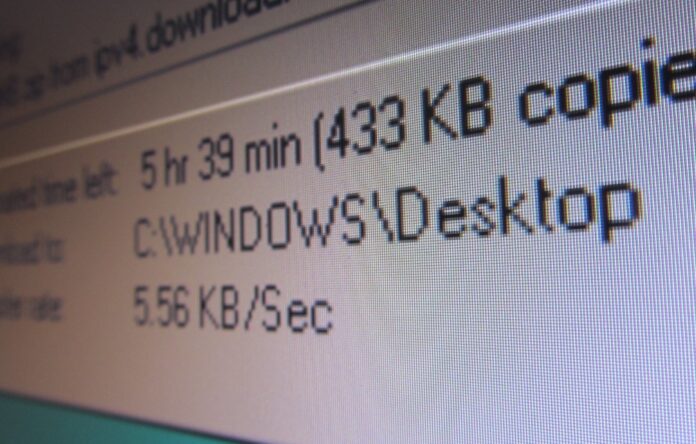
Living in the technological age, we’ve come to accept that our digital devices and systems will keep improving indefinitely.
Back in the real world, there are appreciable limits on what is possible, what we need, and at which point diminishing returns take over.
Internet speeds are some of the most illustrative examples of this concept in action, and we want to look at why.
Downloading in a Flash
To the average user, it might be challenging to appreciate how far internet speeds have come and how much they can act as overkill for our modern needs. As shown by ExpressVPN, a great hypothetical illustration of this speed could be demonstrated by downloading the new Flash movie. At the highest 4K quality, this 2.5-hour movie would weigh in at around 17.5 GB. In a country like Hong Kong, with an average download speed of 292.21 Mbps, this download would take 7 minutes and 59 seconds. In other words, you could watch the movie as it downloaded and still have 2 hours and 22 minutes left once the download was complete.
Keep in mind that while this average speed is fast, it’s still far from the 1 Gbps standard at which technological nations are taking aim. According to Download Time, a 1 Gbps download of this movie would take only 2.5 minutes. The point here is that, even in a hypothetical scenario, we’ve at a level where greater speeds offer no appreciable advantages.
Evolving to Meet Our Needs

Those of us old enough to remember the electronic screams of dial-up modems might remember the joys we felt when MP3s first hit the internet and the pain involved in downloading them. This compressed music version could reduce the typical 40 Mb .wav track you’d get on a music CD to a mere 4 Mb. On a 56k modem, this would reduce the download time from over 1.5 hours in ideal circumstances to around 10 minutes per song.
Of course, actual downloads would usually take at least twice that long, but it still illustrated a fantastic way for us to find music online. For reference, a modern 1 Gbps connection would download even the larger .wav track in less than a second. 56K modems were the best many of us had up to and even after the year 2000, which were too slow to stream acceptable quality video in real-time. A movie like The Flash, were it available on one of these old connections, would take around 745 hours to download, or around 4.4 weeks.
A replacement for dial-up then started to take over the home market around the start of the new millennium. Digital subscriber line, or DSL, was much faster than the 56.6 Kbps users had grown accustomed to, operating around 6 Mbps. It also didn’t block a home phone line while in use, though the extra cost could prove a difficult sell in the early days.

Data limits on early DSL plans would mean this form of the internet still wasn’t perfect, though it evolved quickly. As noted by SpeedGuide, this development took the form of new systems like VDSL and ADSL, which expanded on DSL speed and still serve as the home connections to millions today. Together with larger data caps, the new potential would make real-time streaming possible.
As businesses like YouTube, Spotify, and Netflix arrived at leveraging this potential, by 2010, we could already watch without having to wait for our content. Though resolution and video quality has increased from 720p to the new 4k standard, we’ve never had to go back to waiting.
Overcoming What’s Left
The one big caveat in data transmission comes not from the amount of data that can be transmitted at once, called bandwidth, but from latency. Latency, as the amount of time it takes for a signal to perform a round trip, is impossible to overcome, but it still won’t matter in many cases.
Latency is challenging to improve because the speed of light binds it. We can’t get much closer to the speed of light in data transmission than we already have, and given the distances, web traffic needs to travel, a delay is inevitable. Again, however, this won’t matter to most users. Even if a server was on the other side of the planet, a half-second delay before your media stream begins is hardly an issue.
The other issues arise when looking at the most demanding personal use and large data transfers in business. In video gaming, being unable to play games until they download can be frustrating, but clever programming can also address it. If a title downloads the first section of a game before everything else, waiting times will be minimized.
A modern game like Jedi Survivor can weigh in at a hefty 148 Gb, according to TheNerdStash, which would take 21 minutes on a 1Gbps connection. With clever downloading tricks, waiting for file completion wouldn’t be necessary. Though the same tricks wouldn’t be possible for powerful business software and database downloads, this is not an issue that at-home users must be concerned with.

Reach and Grasp
Taken together, all of this shows us that we’re at a point where our reach finally exceeds our grasp. Like AM radio, there aren’t really any developments that could add much to what already exists, both from a data transmission and visual quality standpoint. We’re at a level where we have everything we need, and users and the market must come to terms with that.
For you, this means that you don’t need to concern yourself with pushing past or even close to the 1 Gbps barrier, but it still could be worth looking for new internet plans. Cheaper plans will often be released without users being told, so be sure to compare your subscriptions with those of competing ISPs to check for better deals. Other than that, it might be time to rest on our laurels, take a step back, and appreciate just how far we’ve come.






